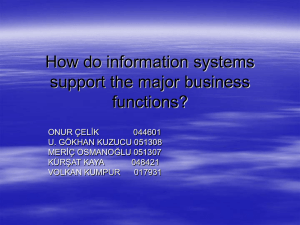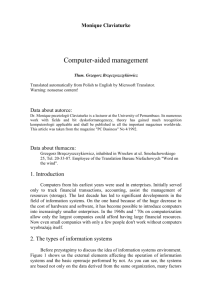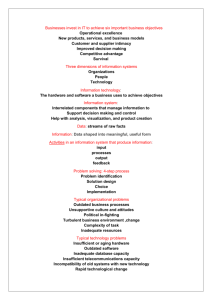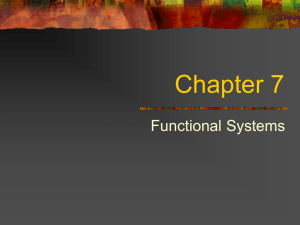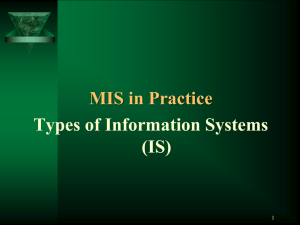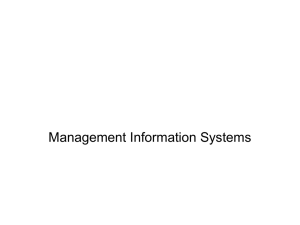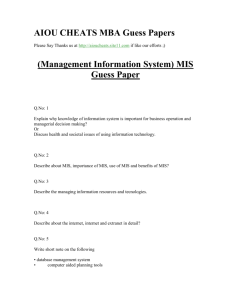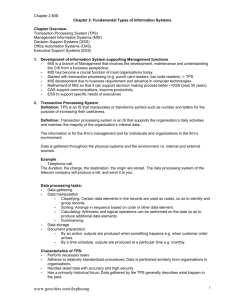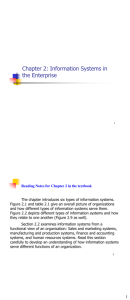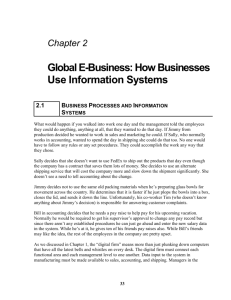a. Customer relationship management systems
advertisement
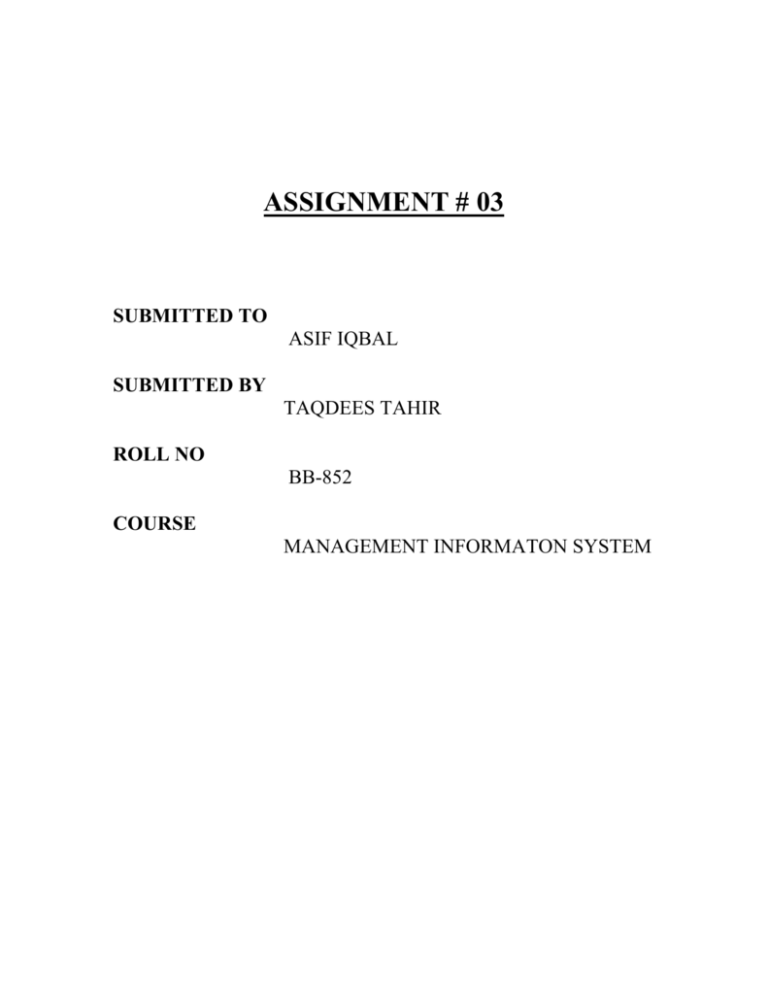
ASSIGNMENT # 03 SUBMITTED TO ASIF IQBAL SUBMITTED BY TAQDEES TAHIR ROLL NO BB-852 COURSE MANAGEMENT INFORMATON SYSTEM QUESTION 1 List and briefly describe the major types of systems in organizations. The major types are; 1. Transaction processing systems: perform and record the daily routine transactions necessary to conduct the business. TPS perform the major lower level work such as order entry, sales management, scheduling, accounting systems. 2. Office automation systems: designed to increase the productivity of data workers in the office. OAS support word processing, document management and storage, electronic meeting and planning (calendars). 3. Knowledge work systems: aid the creation and integration of new knowledge in the organization. KWS support design and analysis such CAD or data analysis. 4. Decision support systems: combine data and sophisticated analytical models or data analysis tools to support non-routine decision-making. Such as cost analysis systems, pricing analysis 5. Management information systems: serve the functions of planning, controlling, and decision making by providing routine summary and exception reports. Such sales and marketing management systems, inventory control, capital budgeting. 6. Executive support systems: address non-routine decisionmaking through advanced graphics and communications. Such as five-year sales trend, profit planning, strategic planning. Question 2 What are the characteristics of MIS? How does MIS differ from TPS? How does MIS differ from DSS? Characteristics of MIS MIS supports the management level by providing routine summary reports and exception reports for various purposes including planning, controlling, and decision-making. Examples include: sales and profit per customer and per region; inventory control; capital investment analysis. MIS differs from TPS in that MIS deals with summarized and compressed data from the TPS and sometimes analysis of that summarized data. Decision support systems provide material for analysis for the solution of semi-structured problems; DSS uses the data from MIS, but is more a "right now" analysis than the long-term structured analysis of MIS. Question 3 List and describe the information systems serving each of the major functional areas of a business? Systems Serving Functional Areas Sales and marketing information systems are systems that help the firm identify customers for the organization's products and services. Such systems help to identify customer preferences, potential customers, sell the products or services, and provide support to salespeople and customers. Specific systems include order processing, market analysis, pricing analysis, and sales trend forecasting. Manufacturing and production information systems are systems that provide information for planning, product development, production or service scheduling, and controlling the flow of products and services. Specific systems might include machine control, production planning and facilities location. Finance and accounting information systems keep track of an organization's financial assets and fund flows. Systems include accounts receivable, portfolio analysis, budgeting, and profit planning. Human resources information systems maintain employee records, track employee skills, job performance, training, employee compensation including pensions and benefits, legal and regulatory requirements, and career development. Systems include training and development, compensation analysis, and human resources planning. Question 4 Describe the relationship between TPS, OAS, KWS, MIS, DSS and ESS? The relationship between these systems is interrelated. TPS are major producers of information that is required by the other systems, which in turn, produce information for other systems. As the office systems provide reports or presentations on the information or data in transaction processing systems, decisionsupport and executive support systems often use office systems in presenting information extracted from transaction processing systems and MIS. MIS depends on the data in transaction processing systems. Some systems, including KWS, DSS, and ESS also sometimes use external information such as stock market information and design information from suppliers. Question 5 What is a business process? Give two examples of processes for functional areas of the business and one example of a cross-functional process? Business Process Business processes are the ways in which organizations coordinate and organize work activities, information, and knowledge to produce their valuable products or services. There are two views-the technical-rational and the behavioral. The technical-rational focuses on activities, and views business processes as concrete flows of material, information, and knowledge. The behavioral model focuses on core competencies, management, and leadership, and focuses on the organization's ways of coordinating work, information, and knowledge. Examples of functional areas and business processes follow: Manufacturing and production: product assembling; quality checking; producing bills of materials. Sales and marketing: identifying customers; customers aware of the product; selling the product. making Finance and accounting: paying creditors; creating financial statements; managing cash accounts. Human resources: hiring employees; evaluating job performance of employees; enrolling employees in benefits plans. Cross function business processes are also prevalent in many organizations. For an example the order fulfillment process, which involves activities performed by sales, manufacturing and accounting functions. Question 6 Why are organizations trying to integrate their business processes? What are the four key enterprise applications for organization-wide process integration? Today organizations/firms are finding that they can become more flexible and productive by coordinating their business processes more closely and in some cases integrating these so they focus more on efficient management of resources and customer services. Enterprise applications are designed to support organization-wide process coordination and integration. Enterprise system creates an integrated organization-wide platform to coordinate key internal process of organization/firm. Enterprise Applications a. Customer relationship management systems b. Supply chain management systems c. Collaborative commerce and industrial networks d. Enterprise systems Customer Relationship Management Customer relationship management (CRM) is a business and technology discipline to coordinate all of the business processes for dealing with existing and potential customers. Supply Chain Management Briefly, supply chain management is the close linkage of activities involved in the processes of buying, making and moving a product. Supply chain management is so important to a business because through its efficiency it can coordinate, schedule, and control the delivery of products and services to customers. Collaborative commerce Collaborative commerce uses digital technologies to enable the members of the supply chain to collaboratively design, develop, build, and manage products through their lifecycles. It helps the various partners to integrate their systems with each other. Enterprise Systems Enterprise systems integrate the key business processes of an organization into a single software system. Data from various functional areas are maintained centrally where they can be accessed and used by other functions and cross-functional processes. This changes the workflow of an organization. Now information can flow throughout the organization, improving coordination, efficiency, and decision-making.

